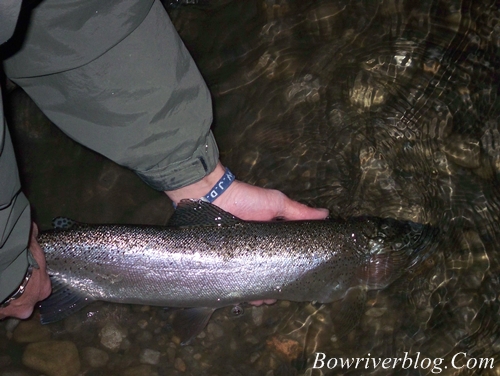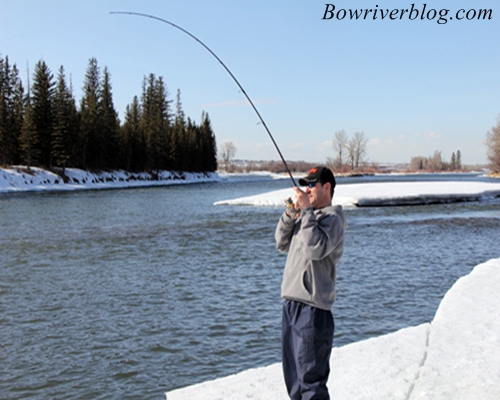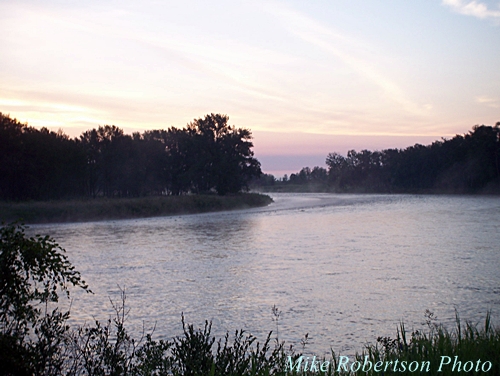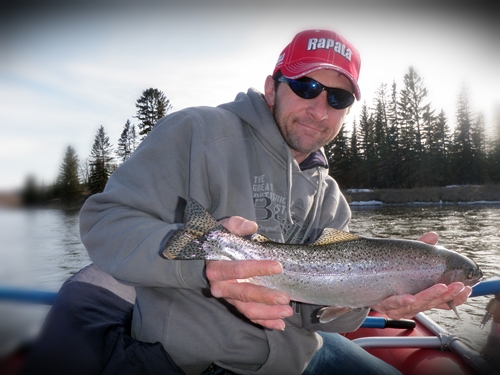
Managing Our Fisheries Resources
The Demand for Fish Exceeds Supply
Alberta does not have an abundance of fish habitat; only 2.4 percent of Alberta is covered with fresh water. About 800 Alberta lakes contain native game fish populations. Compare this to Saskatchewan’s estimated 94,000 fish-bearing lakes, Manitoba’s 110,000 and Ontario’s 250,000! Another 250 to 300 Alberta water bodies (such as municipal ponds) are stocked annually with rainbow trout. Alberta’s human population has been quickly increasing over the past 30 years. Most people live in the central and southern parts of the province, while most of our fish-bearing waters are in the north. This results in a high demand on the fish resources in the more accessible waters. Fish populations in Alberta have declined as a result of over harvest and habitat alteration.
Other factors can place more strains on the population. Several species of prey and sport fish are known to hybridize or reproduce with other genetically similar species. For example, white suckers hybridize with longnose sucker, and lake whitefish hybridize with Cisco. While this is a natural phenomenon occurring when similar species spawn in the same area at the same time, hybridization
becomes a concern when native fish hybridize with non-native fish, such as Cutthroat Trout hybridizing with rainbow trout. These hybrids, called cutbows, along with all other hybrids, are sterile and use food and space needed by other fish which can reproduce and help sustain the population. In addition, these hybrids dilute the gene pool of sport fish native to the watershed.
How Are Our Fish Resources Managed?
Actually, it’s not the fish resources that are managed; it’s the users of the resource who are managed with regulations concerning how, when, where and how many fish can be harvested. The impacts of all users — recreational (sport), domestic and commercial — are taken into account, including angling release mortality and the by catch of non-target species in domestic and commercial fishing.
Managing for conservation requires both the control of fish harvest and the protection of fish habitat. While Alberta Sustainable Resource Development is responsible for managing our fish resources, Alberta Environment, through the Water Act, protects the aquatic environment and ensures the wise use of water resources.
Tools used by fisheries managers to regulate the sport fishery include season and area closures to protect spawning fish, catch limits to distribute the available harvest of fish among many users, size limits to ensure enough fish of spawning size survive to sustain the population, gear restrictions to support ethical conduct, and bait restrictions to ensure hooks are not taken too deeply, causing hooking mortality. Careful handling and quick release increases fish survival. For the domestic net fishery, license holders are authorized to set one net of 95 meters (100 yards) per lake; a minimum mesh size is specified so that only the larger, mature fish that have already spawned a number of times are harvested. Streams and rivers, and the mouths of tributaries, are closed to fishing so that over harvest does not occur, and at certain times of the year, areas in some lakes are closed to fishing in order to protect spawning fish. In addition, depth restrictions, or controlling the depth at which nets can be set, protect vulnerable fish stocks while still allowing the harvest of more plentiful fish species such as lake whitefish. Fish caught by domestic fishing license holders are for their household use only as a source of food and cannot be sold.
Participation in the commercial net fishery is also tightly controlled. Licensed fishermen must abide by gear restrictions, and season and area closures, including depth restrictions. Most commercial fishing regulations are geared to maximize the catch of target species such as lake whitefish, while minimizing the incidental catch of non-target species such as walleye, northern pike and lake trout. Quotas for the maximum amount of a target species that can be harvested are set on a lake-by-lake basis, as are tolerance limits for the maximum amount of non-target species that can be harvested. Each commercial fishery is monitored closely and closed once a target species quota or a non-target species tolerance limit is met or exceeded.
The Regulation-setting Process
The regulation-setting process seeks to strike a balance between the desires of the users of the resource (demand) and the resource available to be used (supply). This process relies on clear, two-way communication between fisheries managers and the public. The exchange of scientific data and user expectations result in better regulations and better regulation compliance.
During the development of management and recovery plans for walleye, northern pike and the eastern slopes trout fisheries, there was extensive public consultation. The regulations that resulted from this process are complicated in that they are water body/species specific. Biologists and anglers agree that this is the best way to recover and maintain fish populations because the allowable harvest is linked to the productive capability of each fish population and the productive capacity of the water body.
In the future, regulations may begin to take into account the interactions of species, so that regulations for all species in a water body, especially where species such as walleye and northern pike compete for the same food source, will be adjusted to provide the fishery the public desires. For example, this could mean developing regulations to support a good walleye fishery or a good pike fishery, in place of regulations that would have supported only an average walleye/pike fishery. However, this requires a great amount of information about each water body and population.
Critical to the regulation-setting process is information on the age and size distribution, and growth rates of each fish population. With the assistance of the Alberta Conservation Association, volunteers, and conservation groups such as Alberta Fish and Game Association and Trout Unlimited, fish population inventories are conducted using such tools as creel census, test netting and electrofishing. Information on spawning success and recruitment (rate of
reproduction) is very important as well.
Making Sense of Regulations
Some of the regulations require the angler to have a clear understanding of fish biology for the regulations to even make sense. For example, some anglers believe that large fish produce the most eggs and therefore should be released. This belief is contrary to fish biology; biologists know that having more medium sized fish in a population is more beneficial because their egg-producing capacity is greater than that of a few large fish. And the eggs are of better quality, too. Minimum-size limits are good management tools that protect fish populations while providing anglers with an opportunity to catch and keep large fish.
Fish Stocking
It is illegal to release live fish or live fish eggs into any waters except back to the waters from which they were taken. The Alberta Government’s fish stocking program (currently administered by Alberta Sustainable Resource Development) is one exception to this rule. Each year, about four million fry and fingerlings from different species of sport fish are raised and stocked in reservoirs, lakes, and constructed ponds which cannot support a native fish population. This is done to provide the public with a variety of sport fishing opportunities while taking some pressure off “wild” (non-stocked) fish populations. All fish stocking is consistent with water body management plans, which consider criteria such as water quality, physical characteristics, public interest and the characteristics of existing fish populations.
Protecting Fish Habitat
An equally important aspect of managing our fish resources involves managing people’s activities where fish habitat is concerned. Fish are a product of their habitat, and to produce fish there must be sufficient, suitable habitat available. Work in and around water bodies must result in “no-net-loss”. In some cases adverse impacts are temporary and steps can be taken to minimize these impacts
(mitigation). Longer-term impacts may require other steps to replace or offset the loss of fish habitat (compensation).
Activities that are affected by the guideline of no-net-loss of productive fish habitat include recreational development, timber harvest, agriculture and cattle grazing, petroleum and mineral exploration and extraction, and any other activitythat may affect the aquatic environment. Developers must identify critical habitats for all life stages of the fish affected. Appropriate habitat protection, rehabilitation
and compensation measures need to be included in development plans. The
effectiveness of habitat rehabilitation and compensation actions must be monitored and maintained.
Species of Concern Have a Brighter Future
By the mid-1990s, populations of bull trout, Alberta’s official fish emblem, had declined severely due to over harvest and habitat alteration. However, sport fishing regulations prohibiting the harvest of bull trout (zero catch limit) implemented in 1995 are already having a positive affect. In Lower Kananaskis Lake, where harvest has been prohibited since 1992, there are reports of increased bull trout catch rates and slower growth rates for these fish, both signs of population recovery. Elsewhere in the eastern slopes there are reports that the numbers and size of bull trout are increasing. Again, it is important to know something about fish biology to understand the regulations. While anglers may see an increased
number of bull trout, they should also know that bull trout are not ready to spawn until they are about six years of age, and usually over 40 cm long!
Management plans developed from 1996 to 1998 to maintain and recover populations of walleye, and east slopes cold-water fish species such as Arctic grayling, rainbow trout, brown trout and cutthroat trout have brought into place more restrictive regulations. But the restrictions are also more realistic
considering the productive capabilities of these populations and current angling pressure.
The original source of this article lives here http://www.whyte.org/time/riveroflife/fishmgmt.pdf




